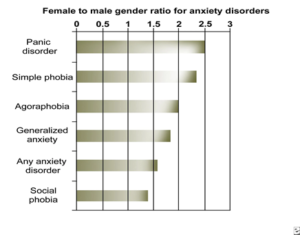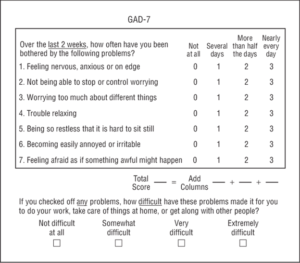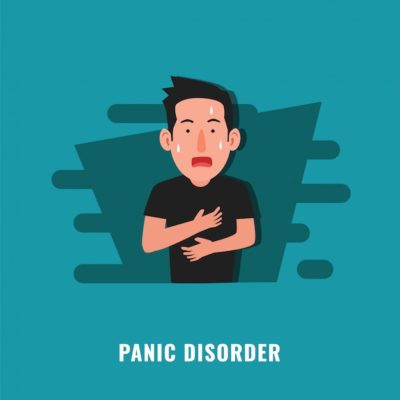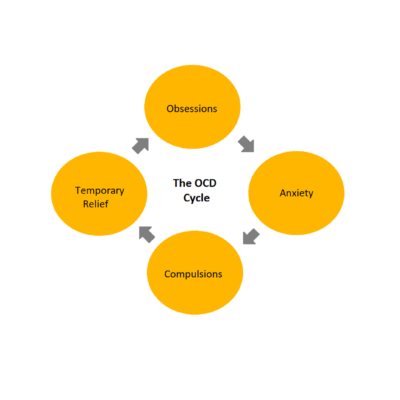
Article Topic: Generalized Anxiety disorder
Author: Ibrahim Alhawaniah
Editor: Ibraheem Alkhawaldeh, Rami AlEmoush.
Reviewer: Ethar Hazaimeh
Keywords: Generalized Anxiety Disorder, Psychiatry, Cognitive-Behavioural Therapy, Anxiety, Mental Disorder.
Overview
Generalized anxiety disorder (GAD) according to the diagnostic and statistical manual of mental disorders (DSM-V), is a subtype of anxiety disorder that is characterized by uncontrollable and excessive anxiety and worry for a period of at least six months that might come with physical symptoms which might hinder the individual’s functional life. [1]
The physical symptoms could be only muscle tension or much worse, like diarrhea and shortness of breath. It has a wide spectrum of associated conditions. [1]
GAD‘s 12-month prevalence among adults worldwide ranges between 0.4% to 3.6% [1]. A study on 811 adult patients in a university hospital in Jordan revealed a prevalence of 23.7%, which is quite higher than the range that’s mentioned in the DSM-V [2], with females being likely to have GAD two times more than males, as shown in Figure (1) [3], and people aged 36-45 as much as five times more than other age groups.

Figure (1) Female to male gender ratio.
Having a lifetime feeling of anxiety and nervousness is not uncommon in people that have GAD, making it hard to establish the exact onset of the disease. However, DSM-V mentions that it rarely occurs before adolescence and its median age of onset is 30 years. [1]
Presentation Course
The development of GAD symptoms and its course is quite the same among all patients in that it tends to be chronic and it waxes and wanes during their lifetime, with rare incidences of full recovery. [1] Also, the earlier patients experience symptoms of GAD, the more likely they would have an impaired life and comorbidities.
In adolescents, GAD tends to inflate their concerns regarding their performance at school or in sports, even if nobody is evaluating them. [1] In children, GAD might be overdiagnosed, which is why evaluation should be made to establish whether it’s GAD or other disorders like separation anxiety disorder or obsessive-compulsive disorder, which tend to come with symptoms that mimic GAD’s symptoms.
Diagnosis
DSM-5 diagnostic criteria of GAD include[1]:
A – Excessive anxiety and worry, occurring more days than not for at least 6 months, about several events or activities (such as work or school performance).
B – The individual finds it difficult to control the worry
C – The anxiety and worry are associated with three (or more) of the following six symptoms (with at least some symptoms having been present for more days than not for the past 6 months):
Note: Only one item is required in children.
- Restlessness or feeling keyed up or on edge.
- Being easily fatigued.
- Difficulty concentrating or mind going blank.
- Irritability.
- Muscle tension.
- Sleep disturbance (difficulty falling or staying asleep, or restless, unsatisfying sleep).
D – The anxiety, worry, or physical symptoms cause clinically significant distress or impairment in social, occupational, or other important areas of functioning.
E – The disturbance is not attributable to the physiological effects of a substance (e.g., a drug of abuse, a medication) or another medical condition (e.g., hyperthyroidism).
F – The disturbance is not better explained by another mental disorder (e.g., anxiety or worry about having panic attacks in panic disorder, negative evaluation in social anxiety disorder [social phobia], contamination or other obsessions in obsessive-compulsive disorder, separation from attachment figures in separation anxiety disorder, reminders of traumatic events in posttraumatic stress disorder, gaining weight in anorexia nervosa, physical complaints in somatic symptom disorder, perceived appearance flaws in body dysmorphic disorder, having a serious illness in illness anxiety disorder, or the content of delusional beliefs in schizophrenia or delusional disorder).
- A mental status examination should assess two things in GAD [4]. Number one includes asking about suicidal/homicidal ideation or plan, such as the following:
- Have you ever wished you were never born, thought you would be better off dead, wished to harm yourself or others, have the plan to harm yourself or others, or ever tried to kill yourself or seriously injure yourself or others?
Number two includes a formal examination of orientation/recall, like :
- Does the patient respond when you call them by name (oriented to person)?
- Is the patient oriented to place and time? When you ask what place, season, day, month, the year is it, does the patient respond appropriately?
- Does the patient have an intact short- or long-term recall? Ask the patient to spell the word “WORLD “forward and backward, count backward from 100 by 7s, and recall what he or she did to celebrate his or her birthday last year and the name of his or her first-grade teacher.
However, an easier and more practical way to diagnose GAD in clinical settings, especially in primary care is to use the GAD-7 tool, which is shown in Table (1), as it has proved its good reliability to diagnose the disorder [4].

Table (1): GAD-7
Workup
When a patient is suspected to have an anxiety disorder including GAD, the workup that is done consists of the following[5]:
1 – Complete blood cell count
2 – Chemistry profile
3 – Thyroid function tests
4 – Urinalysis
5 – Urine drug screen
- Other studies are also done to exclude certain medical disorders, like excluding CNS disorders with an electroencephalography (EEG), lumbar puncture (LP) or brain computed tomography (CT) scan if indicated by history and clinical findings.
- Electrocardiography (ECG) is done to rule out cardiac disorders such as arrhythmias.
- Arterial blood gas analysis (ABG) is used to check for hyperventilation (respiratory alkalosis) and hypoxemia or metabolic acidosis.
Treatment
GAD’s management includes two main ingredients which are used in synchronization. Those are 1 – Medications and 2 – Psychotherapy.
Psychotherapy is mainly Cognitive-Behavioral therapy (CBT) which is effective in short-term management and for mild cases, especially in kids[6]. combining (CBT) with medicine is the ultimate best option in resistant cases[7].
In certain cases, hospitalization is indicated, these cases are mostly:
- Severe functional deterioration
- Suicide or homicide risk
- Social life impairment
As for medicine, the first line is the selective serotonin reuptake inhibitor (SSRI) and serotonin and norepinephrine reuptake inhibitor (SNRI) classes. Mainly Escitalopram, Duloxetine, Venlafaxine, and Paroxetine.[8]
Risk Factors
1 – Genetics: One-third of patients who have GAD have genetic factors.
2 – Environmental: Parental overprotection has been associated with GAD, but environmental factors have not been identified as a specific cause for GAD.
Recent Advance
A group of patients with refractory-to-treatment GAD was given Ketamine 1 mg/kg weekly for a period of 3 months subcutaneously in a university clinic trial. The patients said that they had better functionality during and after the trial, with reports of improvement even within one hour after administering the drug which lasted for a week. This sheds light on how we can improve our approach to Anxieties in general and GAD, as a such drugs might be used as adjunctive therapy with SSRI, SNRI, and CBT combination therapy to maximize efficiency. Ketamine’s dissociative side effects were found to decrease after multiple doses, and it was found safe to be used as maintenance therapy. [9]






